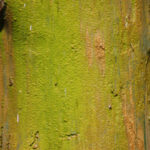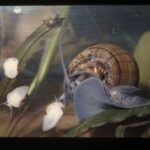A reef tank is a culmination of a plethora of inhabitants that range in size from microscopic plankton and pods to the fish and corals that are so highly sought after. As far as the pods and plankton are concerned, they either populate an aquarium as hitchhikers, often arriving with corals, algae and live rock or can be purchased separately for use to seed and feed various animals residing within an aquarium. The myriad of fish and corals highly sought after represent the stars of the show, so to speak. Without these very colorful and entertaining animals, each with their own personality and behavior trait, many aquariums have a perceived notion of being lifeless and boring. This is where invertebrates make the front page headlines. Snails, for one, depict a source of symbiotic relationships not only with the animals within an aquarium but with the aquarium owner as well. By this I mean they form the groundwork for your tanks cleanliness. Avid aquarists have always held the notion that snails are crucial and beneficial invertebrates to reef biotopes, especially. Based on my many years in the marine hobby, I can say that snails are a credible animal that carries its weight in gold.
The fact that snails come in various shapes, sizes and forms while exuding a multitude of talents when it comes to foraging for food as well as being categorized as prolific cleaners, promotes these invertebrates as one of the better choices to incorporate into a reef aquarium, hands down.
Based on my vast experience dealing with reef aquariums and my experience working in pet shops and countless hours researching various snails for as reef biotope, I have composed a list of the top three snails dedicated to a reef aquarium, based on their hardiness, ease of purchasing and their utmost importance when it comes to helping to ensure your tanks is free of nuisance microalgae. Snails consume great amounts of algae within a tank which is very exciting to aquarists, as it limits the amount of time that they need to spend cleaning their rock, glass tank and algae growth that is prominently seen growing on corals, which effects these delicate animals immensely.
The first snail is called the Cerith snail. Its Latin Name is Cerithithium sp. It attains roughly 2-3 inches in length and is encountered in a conical shell black and white. These snails are ideal and probably the best suited for a reef tank of any size. Cerith snails will be found in the benthic areas of an aquarium searching for diatoms, algae and sediment, hence cleaning the substrate as well as aerating it is well. Moreover, they will also consume algae that forms on inside glass of aquariums, heaters, filters and other pieces of equipment, not to mention removing algae in intricate areas within a tank such as within coral polyps, coralites and other areas where coral tissue may succumb to algae infestation that promotes an adverse reaction to coral health and growth. These snails are easy to maintain as long as you have a mature tank with which the snails have an ample supply of algae and diatoms to feed upon. A nice side note regarding these unique animals is the fact that they can right themselves if they fall off a rock or the tank glass, unlike their cousins, the Turbo snail where if they land upside down and you don’t personally right them, they will eventually die or get eaten by other inhabitants such as hermits and crabs in general.
The second snail that no tank should be without is the Nassarius snails. These fancy, olive shape shelled snails are amazing in their own right. They are the only species in its family that will not harm fish, inverts or even humans, yes I said humans. The infamous Cone Snail complete with a probiscus that shoots out basically a hypodermic needle with a toxin to kill its prey on contact is a relative of the Nassarius snail. There have been documented cases of people being stung and killed by the Cone snail. Fortunately, for us conscientious aquarists, we need not be concerned about that nightmare happening in our tanks housing Nassarius snails. Nassarius snails grow no larger than an inch and a half. The larger and hardier of the two species encountered in the marine hobby are from the small island of Tonga. There is another species that hails from the Caribbean, though its size is dwarfed by the Tongan Nassarius snail and its hardiness is sacrificed as well. These snails are easy to maintain if proper food stuff is provided. They feed on detritus, uneaten food and dead animals. They spend most of their life hidden in the sand bed with only their probiscus sticking out like an antennae just waiting patiently for food to come by. No sooner is food introduced into the pelagic area of a tank and the Nassarius snails appear from under the sand bed like a scene out of the 1970’s horror movie “Night of the Living Dead” in search of a meal. The Nassarius and Cerith Snails are equipped to be able to navigate over sand beds, a feat, in and of itself that other snail species can’t claim.
The last snail species that finalizes my top three snails for a reef biotope is the Astrea snail. I know some of you are going to be shaking your heads at this one thinking that I would have selected the Mexican Turbo, Turbo or the Trochus snail. Well, quite frankly the Mexican Turbo Snails are too cumbersome as they attain a large size. The Turbo and Trochus snails really do not have a very long life expectancy, culminated by the fact that I mentioned above that they can’t turn themselves over if they land upside down. The Astrea snail has a unique shaped spiral shell with grooves along the outer part of its shell. They are, often times, seen as a pearly white color with hair or coralline algae growth on their shell. They rarely attain a size greater than two inches which is ideal especially in smaller aquariums, such as nano and pico tanks. These snails are hard workers, constantly foraging rock work and glass for micro and macro algae tuffs. Again, the best case scenario for housing these beneficial janitorial cleaners is to not overpopulate a tank with them and also to provide a suitable tank with compatible tank mates and a mature tank biotope to ensure they will receive ample food sources. You can always supplement dried Nori seaweed or a food that is high in spirulina, kelp and other forms of algae products in it to ensure the snails are receiving beneficial nutrients in a tank undermined with algae growth.
So, there you have it. The top three snails that will have your tank looking spotless, hence allowing you to enjoy your prized possessions without having to spend countless hours and energy cleaning your tank by hand or those mag cleaners. The one thing I will say is that snails, like other cleanup crew members of a reef tank all provide different keys towards maintaining a clean aquarium, however, if you are encountering an algae outbreak, the best thing you can do is to perform a water change, test your water to see how high your nutrients levels, such as nitrates and phosphates, are in your aquarium water. Ultimately, low dissolved organics and nutrient levels will provide the best results with maintaining a pristine aquarium. It may be that your lights are being left on too long or the bulbs need to be replaced. It may be possible that you are overfeeding or your bioload is too extreme for a tank not dedicated to handle the oversized population. Whatever the case may be there is always a way to rectify a problem before it spirals out of control and that is it is always better to be proactive rather than reactive.





